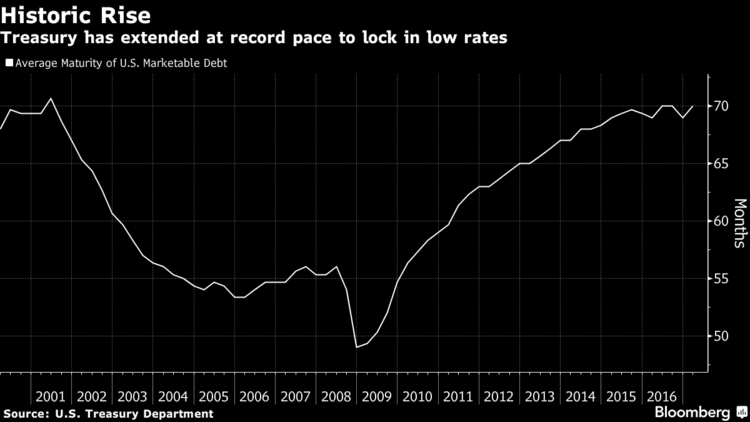From the moment that Steven Mnuchin first hinted back in November that the Trump administration would entertain the idea of selling ultra-long bonds, the consensus across Wall Street was pretty clear: Don’t do it. There’d be no easy way to lure a steady stream of buyers, the skeptics said, and the initiative could prove costly to U.S. taxpayers.
But it seems Mnuchin has different ideas. Since taking office as Treasury Secretary in February, he’s repeatedly indicated that ultra-long issuance was something the administration was looking at. Last month, he had his staff query bond dealers about how they might structure and price maturities beyond the current 30-year limit. And on Monday, Mnuchin provided the clearest signal yet, saying on Bloomberg TV that it “could absolutely make sense.”
Suddenly, the buzz on Wall Street is that, financial considerations aside, the administration’s ambitious, pro-growth agenda could make ultra-long bonds a reality in the Treasury market.

The Treasury seems “committed to the idea that we are going to issue debt that is greater than 30 years,” said Jim Bianco, the Chicago-based founder of Bianco Research, who has been following the U.S. bond market for nearly four decades. “It’s a change in the calculus from the previous administration.”
Of course, the idea has always seemed like a long shot -- not only on Wall Street but inside the U.S. Treasury Department itself, which over the years has repeatedly passed up on the opportunity. But after Mnuchin’s most recent comments, bond traders are taking notice.
Yields on longer-term Treasuries jumped, with the gap between five- and 30-year yields reaching the widest since February. Long bonds ended at 3 percent on Monday.
For Mnuchin, the attraction of issuing ultra-long bonds at today’s historically low interest rates isn’t hard to understand. It would allow the government to borrow vast amounts of money that wouldn’t have to be paid back for a half-century or more, and help fulfill two of President Donald Trump’s biggest campaign promises: fix the nation’s aging infrastructure with a trillion-dollar spending program and cut taxes at the same time.
Panama Canal
It’s not without precedent. In 1911, the U.S. sold 50-year bonds to fund the construction of the Panama Canal -- the most expensive construction project in American history at that time. Gary Cohn, Trump’s top economic adviser, talked up in an interview on CNBC the “enormous amount” of ultra-long bonds the government could issue to finance spending on infrastructure, an area of chronic under-investment for decades.
“It’s a reasonable probability that the Treasury will issue these bonds,” said Scott Mather, chief investment officer for core strategies at Pimco, which oversees $1.5 trillion. The argument is that the U.S. “won’t have to pay much to gain more certainty and the ability to lock-in low rates for a long time.”








